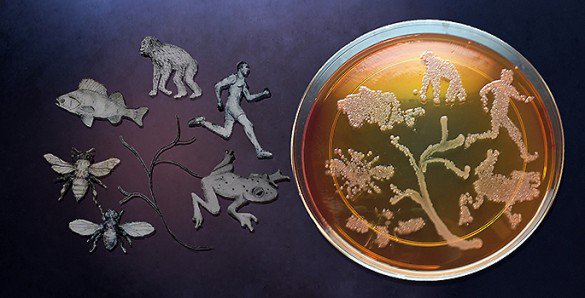
Sept. 28, 2017
Research Highlight
The Balance of Hydrogen Isotopes in Fatty Acids and Environmental Water
New study sheds light on the fractionation of hydrogen isotopes in microbial lipids and environmental water

A picture of the tree of life created using microbes on a Petri dish.Image credit: Robert Brucker, Vanderbilt University.
A team of scientists has provided new data about the fractionation of hydrogen isotopes between environmental water and those found in microbial fatty acids. Fractionation of hydrogen isotopes refers to the ratio of 2H and 1H isotopes, and this ratio provides information about microbial metabolism and the isotopic composition of the water in which microbes live. The mechanism of fractionation is not fully understood.
In the new study, the team looked at the Gram-positive, obligately thermophilic anaerobe, Thermoanaerobacterium saccharolyticum. When removing a single gene, nfnAB, from wild-type strains of the microorganism, the team found that growth rates were reduced and a consequent decrease in lipid/water H isotopic fractionation occurred. The findings indicate that nfnAB and growth rate play a role in the fractionation of hydrogen isotopes in microbial lipids and environemental water.
The study, “Hydrogen isotope composition of Thermoanaerobacterium saccharolyticum lipids: comparing wild type to a nfn- transhydrogenase mutant,” was published in the journal Organic Geochemistry. The work was supported by NASA Astrobiology through the Exobiology & Evolutionary Biology Program.